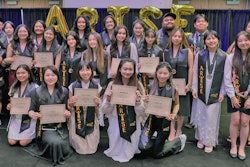When social conflicts arise within their communities, Pacific Islanders have a particular way of finding solutions. They sit in a circle and engage in informal storytelling to find the answers.
The tradition, called TalkStory, is one of many tools that leaders at South Seattle Community College (SSCC) use to engage Asian Pacific American students and their families in confronting their biggest challenges: English language acquisition, poverty, and cultural divides.
Students along with others sit together, sharing personal stories of struggle and triumph in an environment where most assume Asian Americans and Pacific Islanders (AAPI), or Asian Pacific Americans (APA), are excelling. Yet, many are not.
Autasia Sagiao Jr. is one of them, a first-generation college student of Samoan and Filipino heritage. Having grown up in a low-income neighborhood in Seattle, Sagiao is not the prototypical AAPI success story.
College wasn’t even in his plans, Sagiao said, as he struggled to get through high school. His connection with teachers and class material disintegrated while he teetered on the verge of dropping out. Though he loathed his schooling experience, Sagiao “tried out” community college where he found others just like him.
“At SSCC, they understood my background and what I go through; they understand the hardships we face,” said Sagiao, who is now in his third year. “They helped and guided me through all the issues to keep me on track with school work.”
The support Sagiao received was part of a larger effort by the two-year school to target services to an AAPI community undermined by neglect and stereotypes about their success. With a grant from the federal government, SSCC leaders started programs to address the particular needs of a population that is mistakenly assumed to be overrepresented in higher education.
The Seattle community college school is one of eight institutions to receive the federal designation for Asian American and Native American Pacific Islander Serving Institutions (AANAPISI), a new category that recognizes those schools where 10 percent or more of their student body are members of the AAPI community and where at least a quarter qualifies for financial aid.
Before the AANAPISI grant, TalkStory would not have been possible at SSCC. Sagaio would never have been able to take a class in Pacific Islander anthropology. SSCC students would have had a difficult time transitioning from English-language classes to general college courses.
Like other underserved communities, some AAPI leaders often lack the resources and capacity to advocate for their particular group, but they are further burdened by beliefs that mischaracterize their advantages and ignore their disadvantages.
“It’s hard to get people to see Asian Americans as struggling in higher education,” said Mark Mitsui, a vice president for student services at SSCC. “The model minority myth had done a lot of damage in the development of various segments of our community.”
Dr. Robert Teranishi, associate professor of higher education at New York University, said higher education officials are oblivious to the risk factors of AAPI students, especially recent immigrant and refugee communities.
“It’s hard to find the resources needed to support work in this area. Even with research, advocates simply don’t have the capacity to work on these issues,” said Teranishi, who is also the principal investigator of the National Commission on AAPI Research in Education, also known as the CARE project. “They are trying to be responsive to the needs of the community on the ground and at the same time trying to advocate when it comes to policy.”
Leadership on AAPI issues has been relegated to local efforts in past years, but Teranishi, Mitsui, and others are leading a crusade to capture the government’s attention—and they have been gaining ground.
“We are reaching a point where there is a critical mass around the issue,” said Rosannette Rimando, student success and retention project developer with SSCC. “Thank goodness it was the perfect storm that finally got the momentum going.”
In 2007, the AANAPISI category was established as part of the College Cost Reduction Act and later championed by U.S congressmen Mike Honda (D-Calif.), David Wu (D-Ore.), and others. In 2008, it was recognized under Title III of the Higher Education Opportunity Act, and institutions began to apply for one-time, two-year grants for improving AAPI student success.
Six schools—the University of Hawaii, Hilo; South Seattle Community College; the University of Maryland, College Park; Guam Community College; the City College of San Francisco; and Foothill-De Anza Community College—have received $10 million in grants. Queens College in New York and Santa Monica Community College in California qualified for AANAPISI designation in 2009.
“One in 10 of all AAPI students nationally attend one of these campuses. They (were) enrolling about 50,000 AAPI undergraduates in the 2006-07 year,” Teranishi said. “With this money they are able to target a large sector of the AAPI undergraduate population. The funding is reaching its intended population.”
The Congressional Research Service found that nearly 116 institutions are eligible for the AANAPISI designation, many of which are two-year schools. Asian Americans represent 7 percent of the community college student population, according to the 2010 CARE report.
AAPI students at two-year institutions show lower levels of academic preparedness, persistence, and completion than their four-year counterparts. They are often non-traditional students of low-income backgrounds who face numerous language and learning barriers like Sagaio.
No one knows this better than the AANAPISI schools. Forming their own TalkStory, the institutions began communicating with one another to share data and information about their programs and students. Impetus has begun to stir nationally around AAPI student issues.
“The stars just started to align,” Mitsui said, adding that President Barack Obama’s move to appoint Dr. Frank Chong, a well-known education and community leader, to the Department of Education and the formation of a presidential advisory committee on AAPI issues culminated in a ripe opportunity for the population’s leaders.
“Part of the challenge now is just making people aware of what we have and what we’re trying to accomplish,” Mitsui noted.
Allies from organizations such as the Southeast Asia Research and Action Center and the Asian Pacific Islander American Scholarship Foundation (APIASF) have collaborated and launched a series of Web chats, seminars and meetings across the country in support of AANAPISI schools. They are launching a resource Web site that will feature reports from all of the AANAPISI institutions about their best practices and programs.
The SSCC’s Rimando said that, although the group is reticent about naming their alliance, AAPI leaders are moving in the direction of forming an organization on behalf of the AANAPISI schools much like the Hispanic Association of Colleges and Universities (HACU) represent Hispanic-Serving Institutions and how the National Association For Equal Opportunity in Higher Education (NAFEO) advocates for historically Black institutions.
“There is a lot of excitement, a lot of hope, and a lot of expectation that this will be a hallmark in the growth in force around AAPI issues,” Mitsui said. “But there is anxiety, too.”
AANAPISIs are working to be formally welcomed into the minority-serving institutions (MSI) family. Rimando said that, without full recognition, private foundations will be reluctant to fund AAPI initiatives the way they have for other underrepresented groups.
Data is also an issue, Teranishi said, because research lumps Asian Americans into one monolithic group and is not disaggregated according to the diversity of the AAPI community’s 30 or more sub-groups.
Finding funds will continue to challenge AAPI advocates, who held the first higher education summit Wednesday in Washington. Raising awareness and refuting the fictions about their population, however, take precedence.
“People believe that there is some truth to all stereotypes, and it surprises me how pervasive these mischaracterizations are. Even when you present data that shows large sectors of the population with low educational attainment, people have a tough time believing it,” Teranishi said. “They just don’t know what to do with that information.”



















